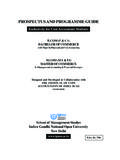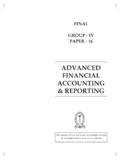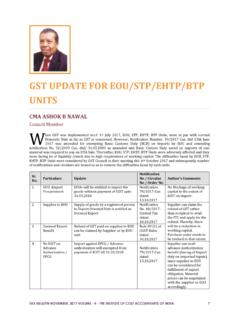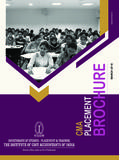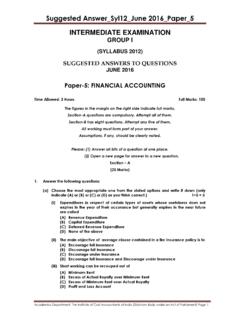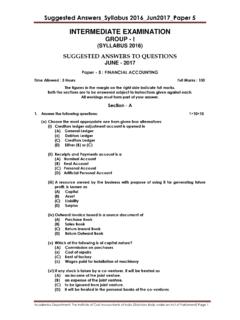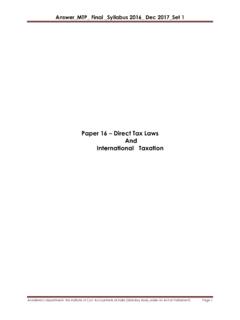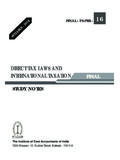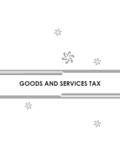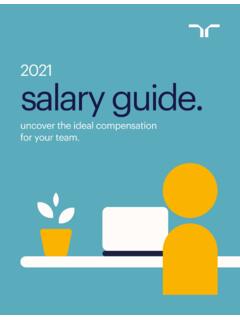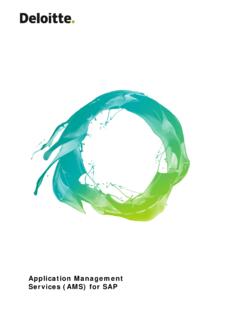Transcription of OPERATIONS MANAGEMENT & STRATEGIC MANAGEMENT …
1 INTERMEDIATE : PAPER -9 INTERMEDIATESTUDY NOTESOPERATIONS MANAGEMENT & STRATEGIC MANAGEMENTThe Institute of Cost Accountants of IndiaCMA Bhawan, 12, Sudder Street, Kolkata - 700 016 SYLLABUS - 2016 First Edition : August 2016 Reprint : April 2017 Reprint : June 2018 Revised Edition : October 2018 Revised Edition : January 2019 Edition : August 2019 Published by :Directorate of StudiesThe Institute of Cost Accountants of India (ICAI)CMA Bhawan, 12, Sudder Street, Kolkata - 700 at :M/s. Sap Prints Solutions Pvt. Ltd. 28A, Lakshmi Industrial EstateS. N. Path, Lower Parel (W)Mumbai - 400 013, MaharashtraCopyright of these Study Notes is reserved by the Institute of Cost Accountants of India and prior permission from the Institute is necessary for reproduction of the whole or any part 9: OPERATIONS MANAGEMENT & STRATEGIC MANAGEMENT (OMSM)Syllabus StructureThe syllabus comprises the following topics and study weightage:AOperations MANAGEMENT 70%BStrategic Management30%B30%A70%ASSESSMENT STRATEGYT here will be written examination paper of three provide an in depth study of the various business process, analyze OPERATIONS , production planning and STRATEGIC AimsThe syllabus aims to test the student s ability to.
2 Understand the business process and analyze the OPERATIONS Acquire knowledge of production planning and resource MANAGEMENT Understand the concept of Corporate Vision - Mission and Objectives Understand the concept of SWOT and Portfolio Analysis Understand the different stages in strategy formulation process Understand the concept of STRATEGIC Business Unit and Business Process re-enginneringSkill Set requiredLevel B: Requiring the skill levels of knowledge, comprehension, application and A : OPERATIONS Management70%1. OPERATIONS MANAGEMENT Introduction2. OPERATIONS Planning 3. Designing of Operational Systems and control 4. Production Planning and control5. Productivity MANAGEMENT and quality management6.
3 Project Management7. Economics of Maintenance and Spares managementSection B : STRATEGIC Management30%8. STRATEGIC MANAGEMENT Introduction9. STRATEGIC Analysis and STRATEGIC Planning 10. Formulation and Implementation of Strategy Syllabus - 2016 SECTION A: OPERATIONS MANAGEMENT [70 MARKS]1. Operation MANAGEMENT Introduction: Scope characteristics of modern OPERATIONS functions - recent trends in production / OPERATIONS OPERATIONS Planning: Demand forecasting capacity planning - capacity requirement planning - facility location - facility layout Resource aggregate planning Material requirements planning Manufacturing resource planning Economic Batch Designing of operational systems and control: Product Design, Process design - Selection - Product Life Cycle Process Planning Process Production planning and Control.
4 Introduction Control Measures Time study, Work study, Method study, Job Evaluation, Job Allocation (Assignment Technique), Scheduling Queuing Models, Simulation and Line Balancing Optimum Allocation of resources Lean OPERATIONS JIT Transportation Model and Linear Programming Technique (Formulation of equations only).5. Productivity MANAGEMENT and Quality MANAGEMENT : Measurement techniques of productivity index, productivity of employee, productivity of materials, productivity of MANAGEMENT resources, productivity of other factors productivity improving methods TQM basic tools and certification ISO standards Project MANAGEMENT : Project planning project life cycle Gantt charts, PERT and Economics of Maintenance and Spares MANAGEMENT : Break down Maintenance Preventive Maintenance Routine Maintenance Replacement of Machine Spare Parts B: STRATEGIC Manangement [30 marks]8.
5 STRATEGIC MANAGEMENT Introduction Vision- Mission and objective9. STRATEGIC Analysis and STRATEGIC Planning Situational Analysis SWOT Analysis Portfolio Analysis BCG Matrices Stages in STRATEGIC Planning Alternatives in STRATEGIC Planning10. Formulation and Implementation of Strategy: Strategy formulation function wise (Production Strategy, Marketing Strategy, Man Power Strategy) Structuring of Organisation for implementation of strategy STRATEGIC Business Unit Business Process Note 1 : Operation MANAGEMENT OPERATIONS MANAGEMENT - Introduction Production MANAGEMENT vs. Operation MANAGEMENT Characteristic of Modern Operation Function Recent Trends in Production / OPERATIONS MANAGEMENT 4 Study Note 2 : OPERATIONS Demand Forecasting Capacity Planning Capacity Requirement Facility Location Facility Layout Resource Aggregate Planning Material Requirements Planning Manufacturing Resource Planning Enterprise Resource Planning Economic Batch Quantity 38 Study Note 3 : Designing of Operational System and Production Design Process Design & Selection Process Planning Product Life Cycle Process Selection 53 Study Note 4.
6 Production Planning and Production Planning and Control Introduction Time Study, Work Study, Method Study & Job Evaluation Job Allocation Assignment Technique Scheduling Queuing Models 82 ContentsSECTION - A : OPERATIONS Simulation Line Balancing Lean OPERATIONS Just-In-Time (JIT) Transportation Model Linear Programming Technique 129 Study Note 5 : Productivity MANAGEMENT and Quality Measurement Techniques of Productivity Index TQM Basic Tools and Certification ISO Standard Basics 163 Study Note 6 : Project Project Planning Gantt Charts PERT and CPM 180 Study Note 7 : Economics of Maintenance and Spares Break Down Maintenance Preventive Maintenance Routine Maintenance Replacement of Machine Spare Parts MANAGEMENT 201 Study Note 8 : STRATEGIC MANAGEMENT Vission, Mission and Objective 227 SECTION - B : STRATEGIC MANAGEMENTS tudy Note 9 : STRATEGIC Analysis and STRATEGIC Situational Analysis SWOT Analysis Portfolio Analysis BCG Matrices Stages in STRATEGIC Planning Alternative in STRATEGIC Planning Pestel Framework Porter s Five Forces Framework Structural Drivers of Change Diversification Strategy 264 Study Note 10.
7 Formulation and Implementation of Strategy Formulation Function-wise (Production Strategy, Marketing Strategy, 267 Manpower Strategy Structuring of Organisation for Implementation of Strategy STRATEGIC Business Unit Business Process Re-engineering Core Competence and Critical Success Factors 290 Section : AOperations MANAGEMENT (Syllabus - 2016)THE INSTITUTE OF COST ACCOUNTANTS OF INDIA 1 This Study Note OPERATIONS MANAGEMENT - Production MANAGEMENT vs. Operation Characteristic of Modern Operation Recent Trends in Production/ OPERATIONS ManagementStudy Note - 1 OPERATIONS MANAGEMENT OPERATIONS MANAGEMENT - INTRODUCTIONO perations MANAGEMENT is the MANAGEMENT of that part of an organization that is responsible for producing goods and/or services.)
8 There are examples of these goods and services all around you. Every book you read, every video you watch, every e-mail you send, every telephone conversation you have, and every medical treatment you receive involves the OPERATIONS function of one or more organizations. So does everything you wear, eat, travel in, sit on, and access the Internet , in order to have a clear idea of OPERATIONS MANAGEMENT , one must have an idea of Operating Systems .An Operating System is defined as a configuration of resources combined for the provision of goods or organizations, hospitals, bus and taxi services, tailors, hotels and dentists are all examples of operating systems.
9 Any operating system converts inputs, using physical resources, to create outputs, the function of which is to satisfy customers wants. The creation of goods or services involves transforming or converting inputs into outputs. Various inputs such as capital, labour, and information are used to create goods or services using one or more transformation processes ( , storing, transporting, and cutting). To ensure that the desired output are obtained, an organization takes measurements at various points in the transformation process (feedback) and then compares with them with previously established standards to determine whether corrective action is needed (control).It is important to note that goods and services often occur jointly.
10 For example, having the oil changed in your car is a service, but the oil that is delivered is a good. Similarly, house painting is a service, but the paint is a good. The goods-service combination is a continuum. It can range from primarily goods, with little service, to primarily service, with few goods. Because there are relatively few pure goods or pure services, companies usually sell product packages, which are a combination of goods and services. There are elements of both goods production and service delivery in these product packages. This makes managing OPERATIONS more interesting, and also more OF OPERATIONS MANAGEMENTO bjectives of OPERATIONS MANAGEMENT can be categorised into (i) Customer service and (ii) Resource utilisation.
